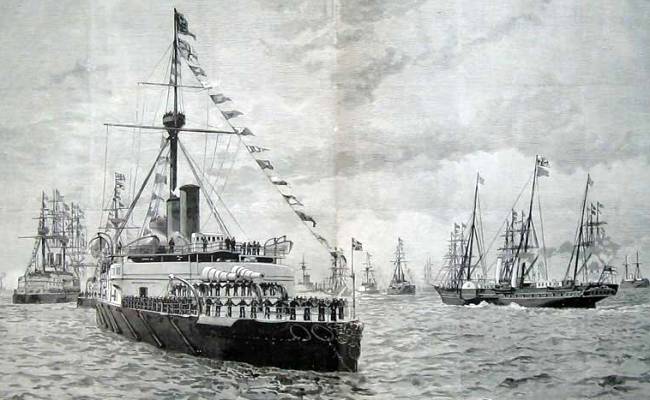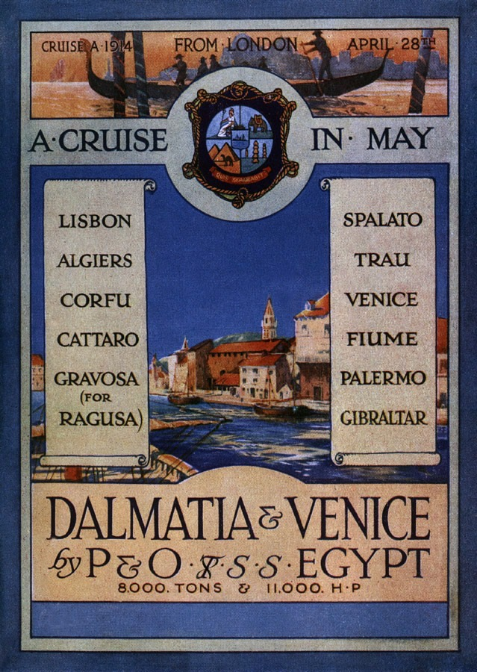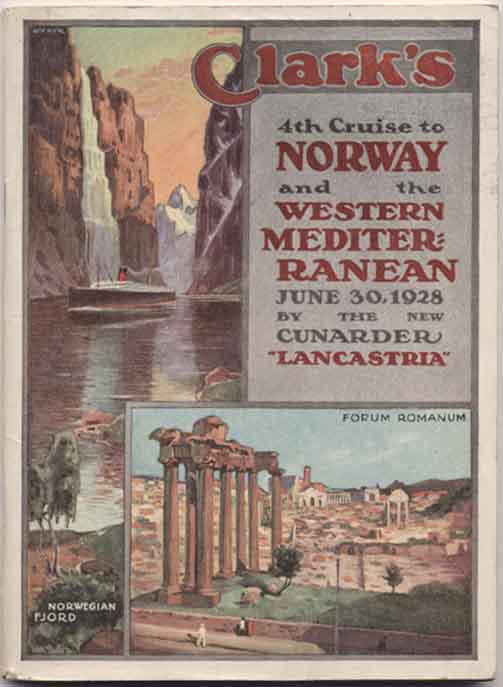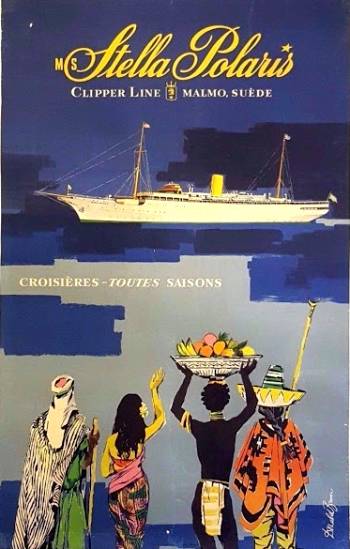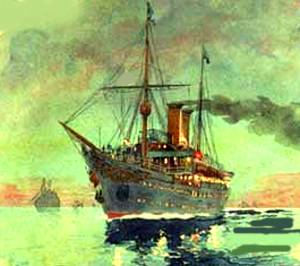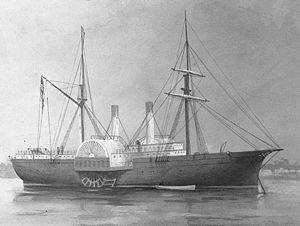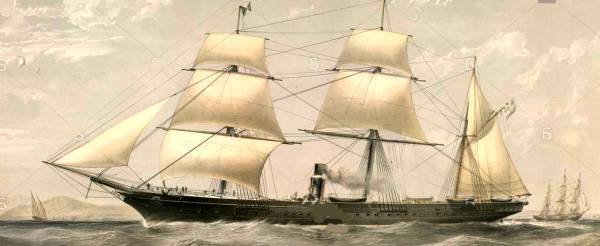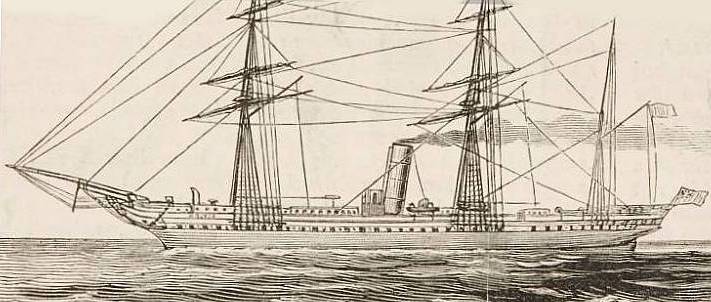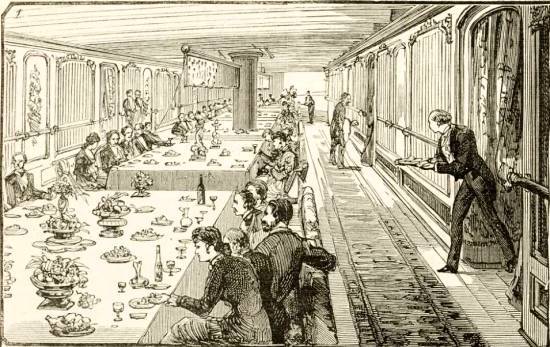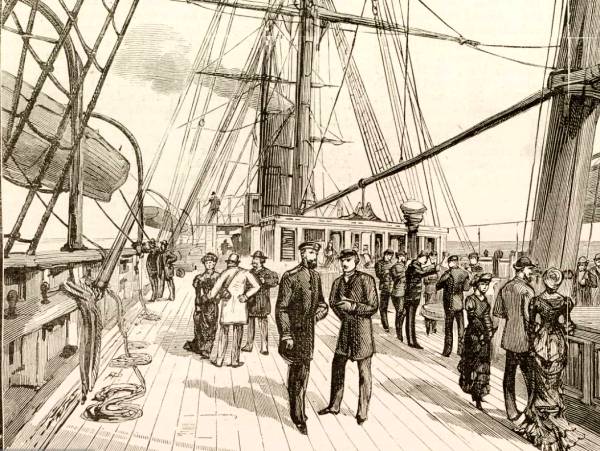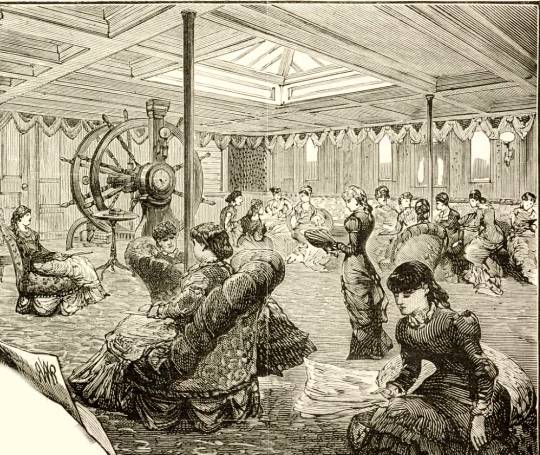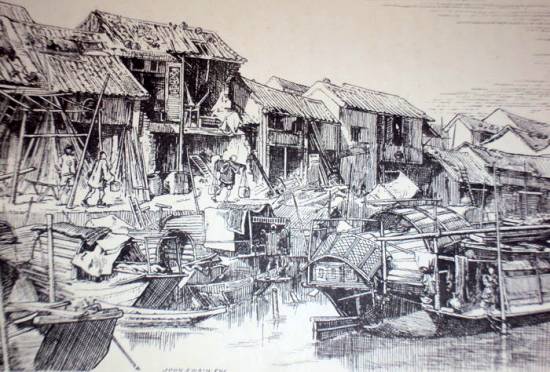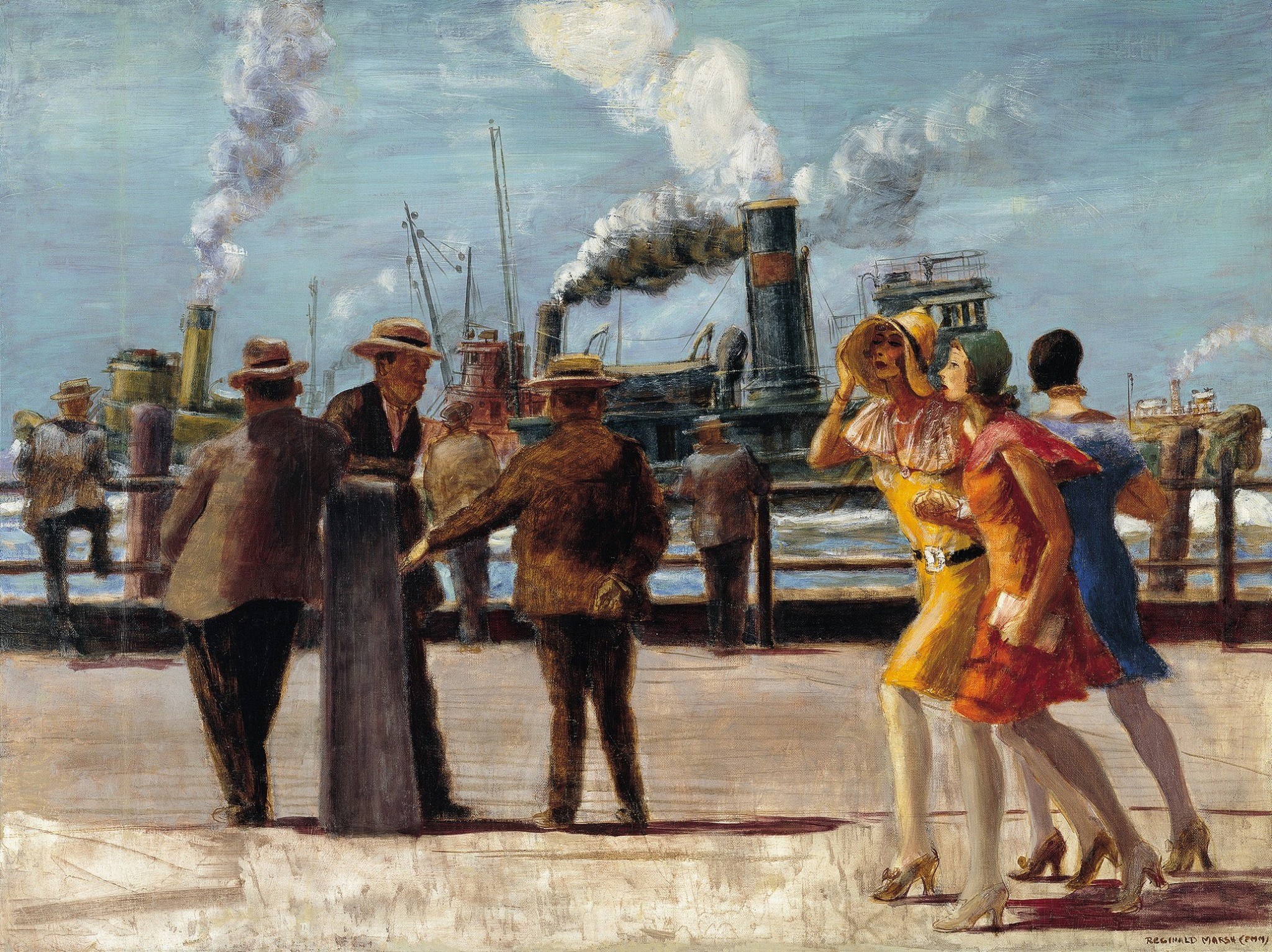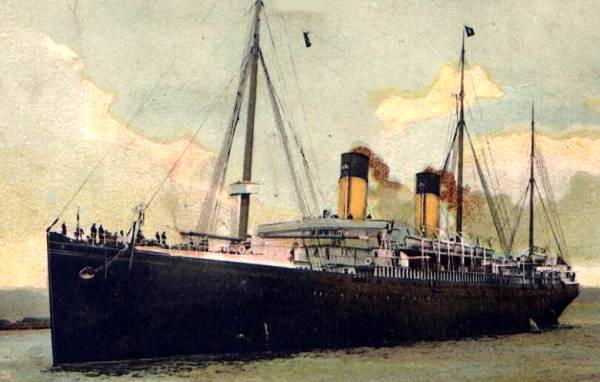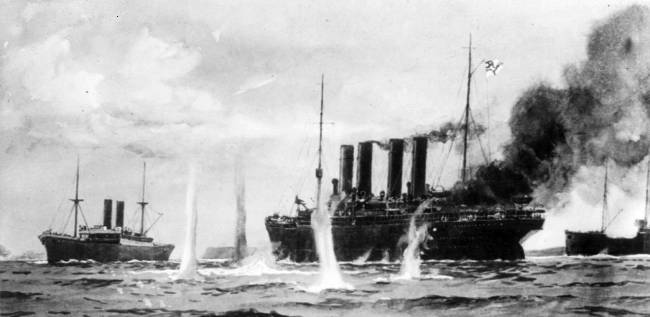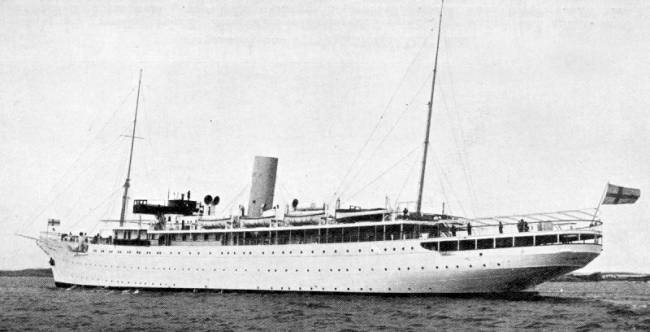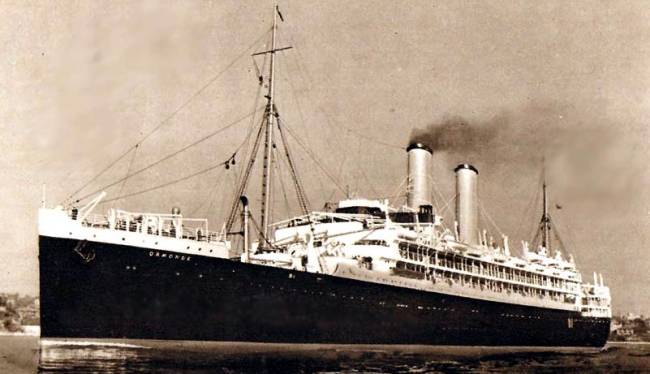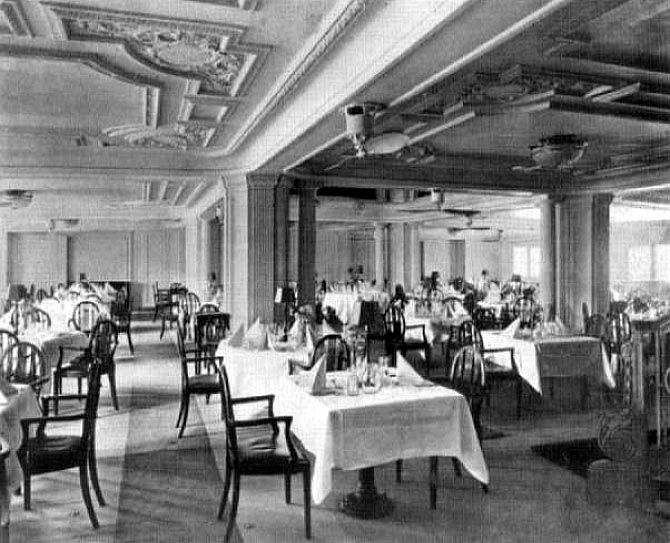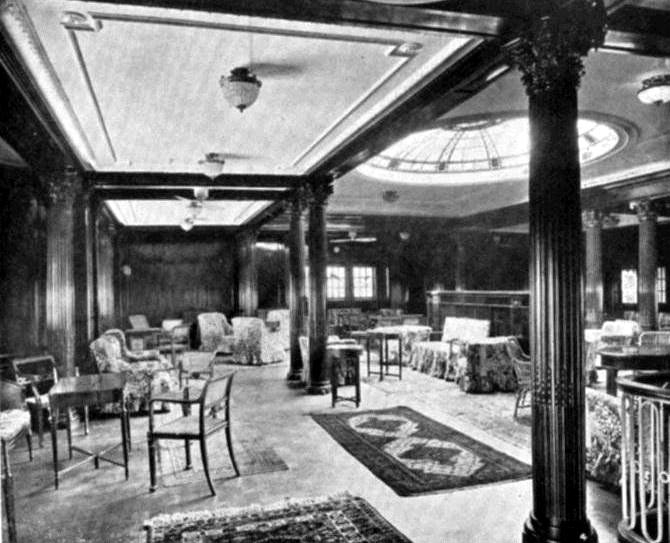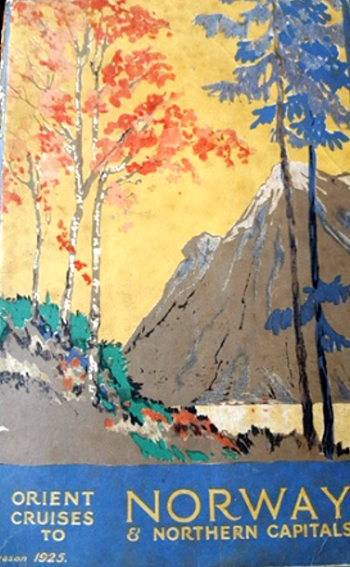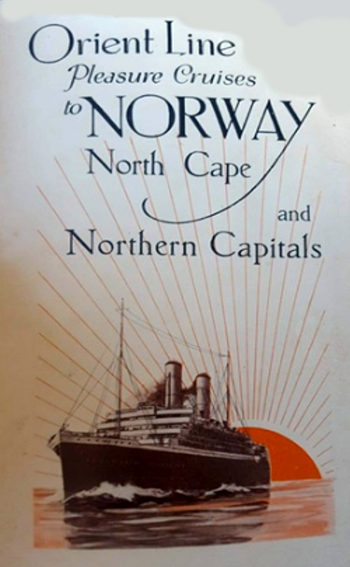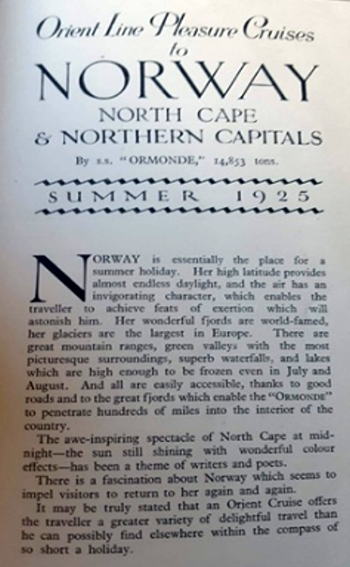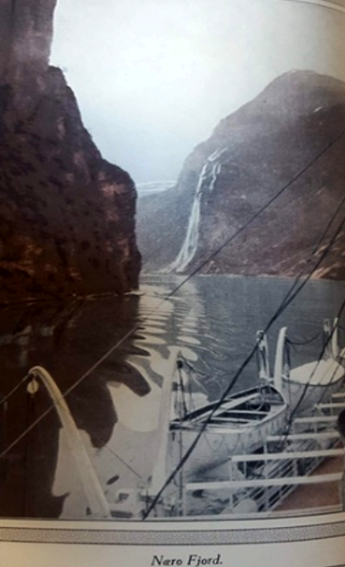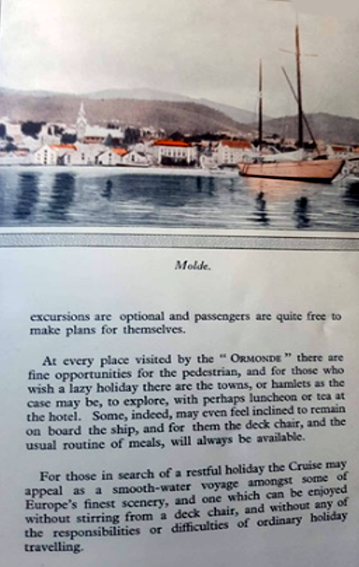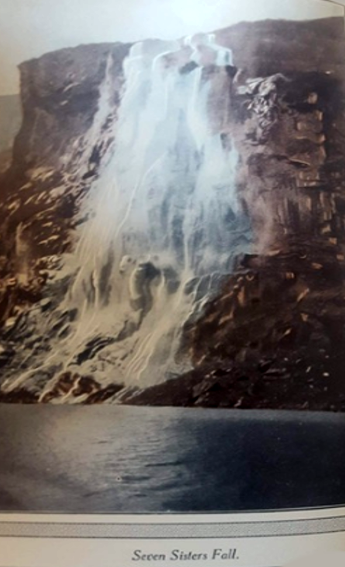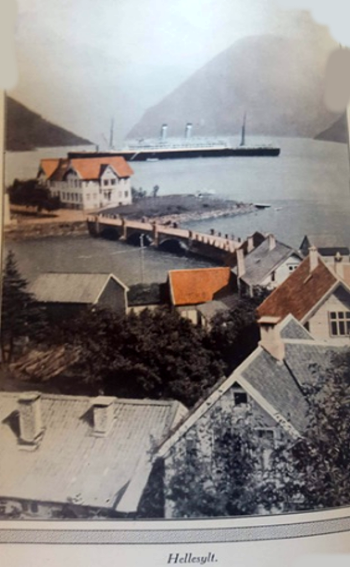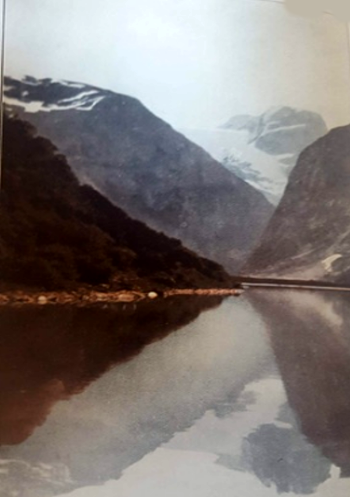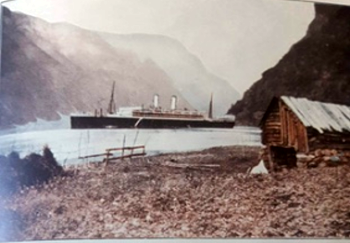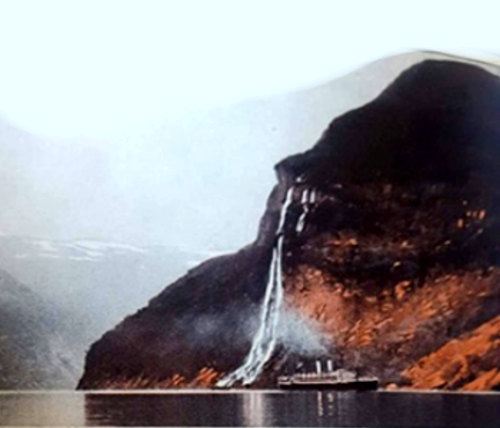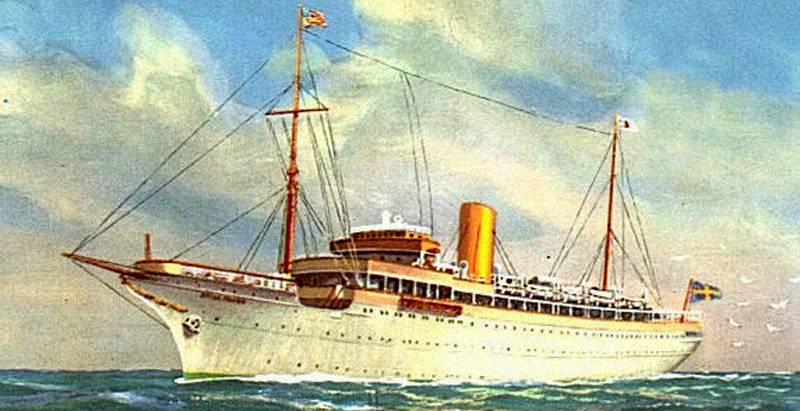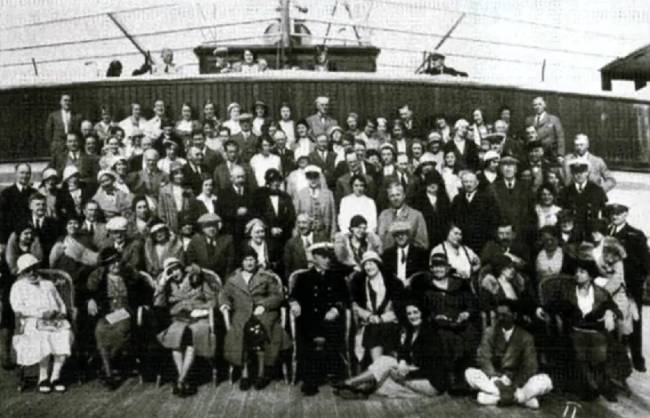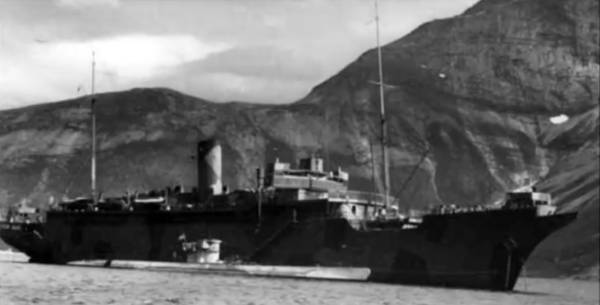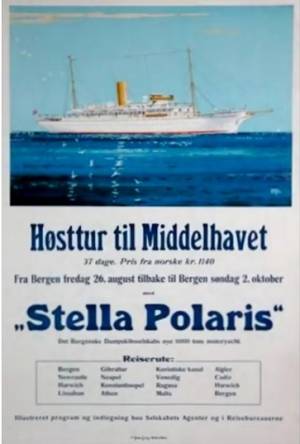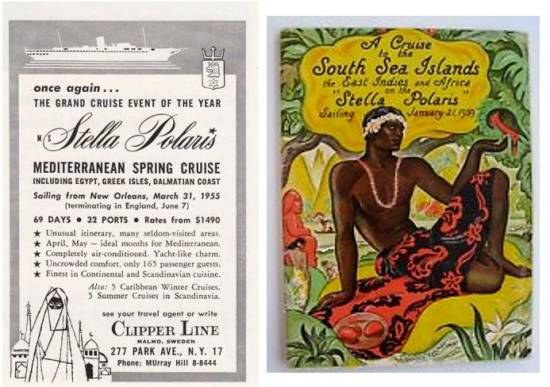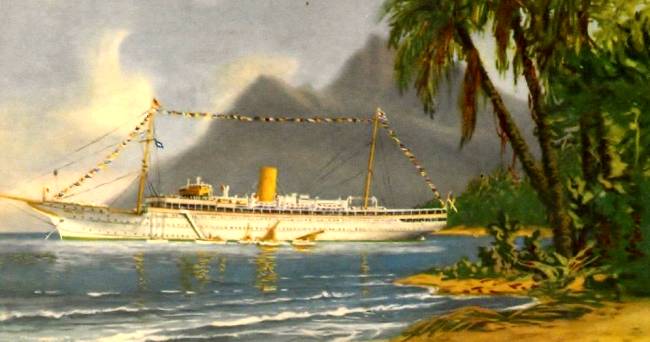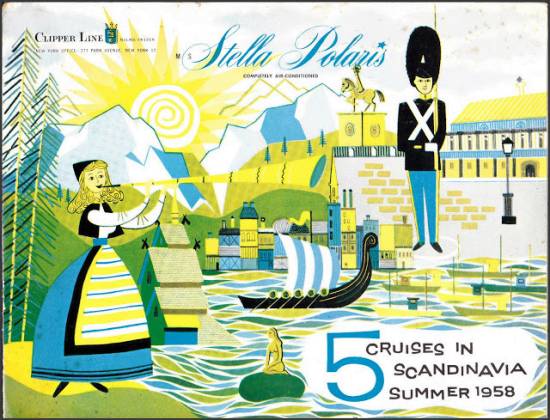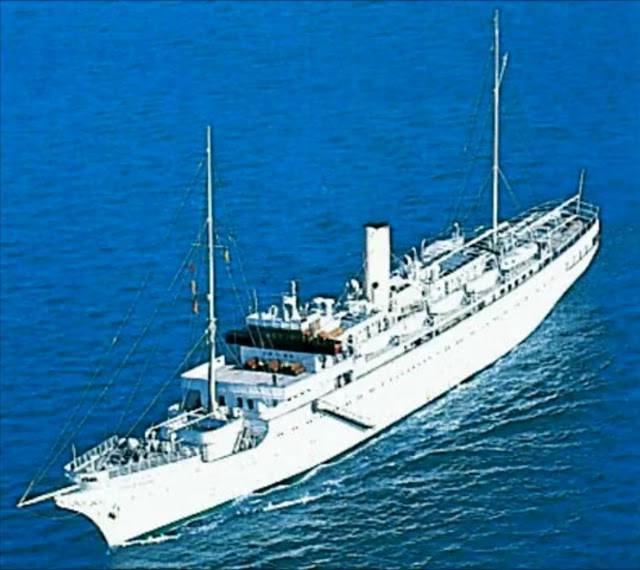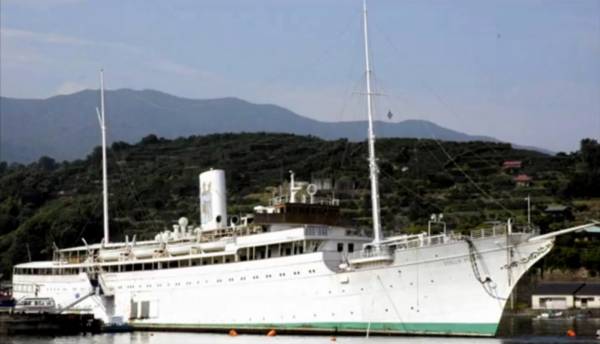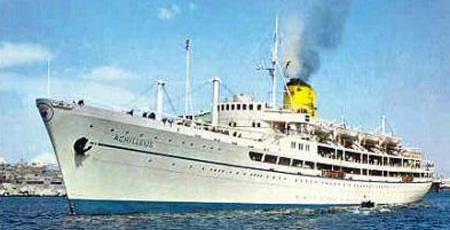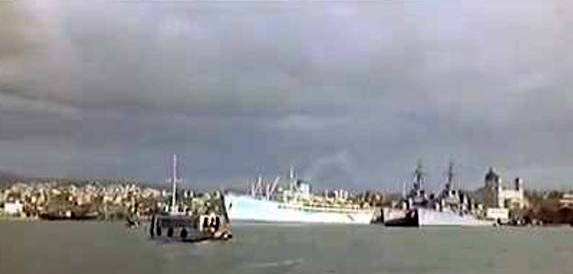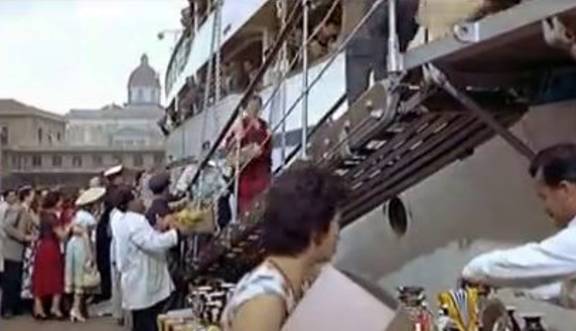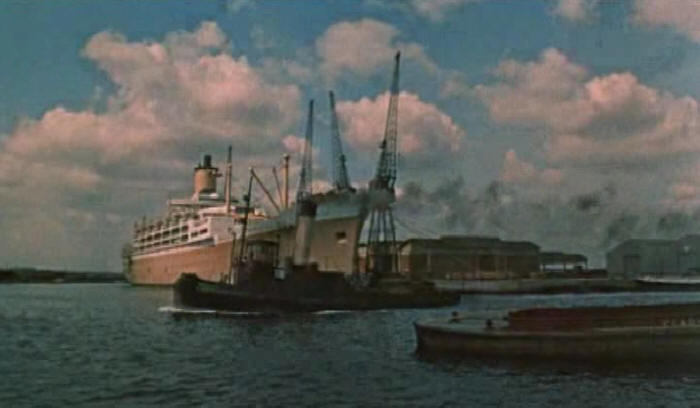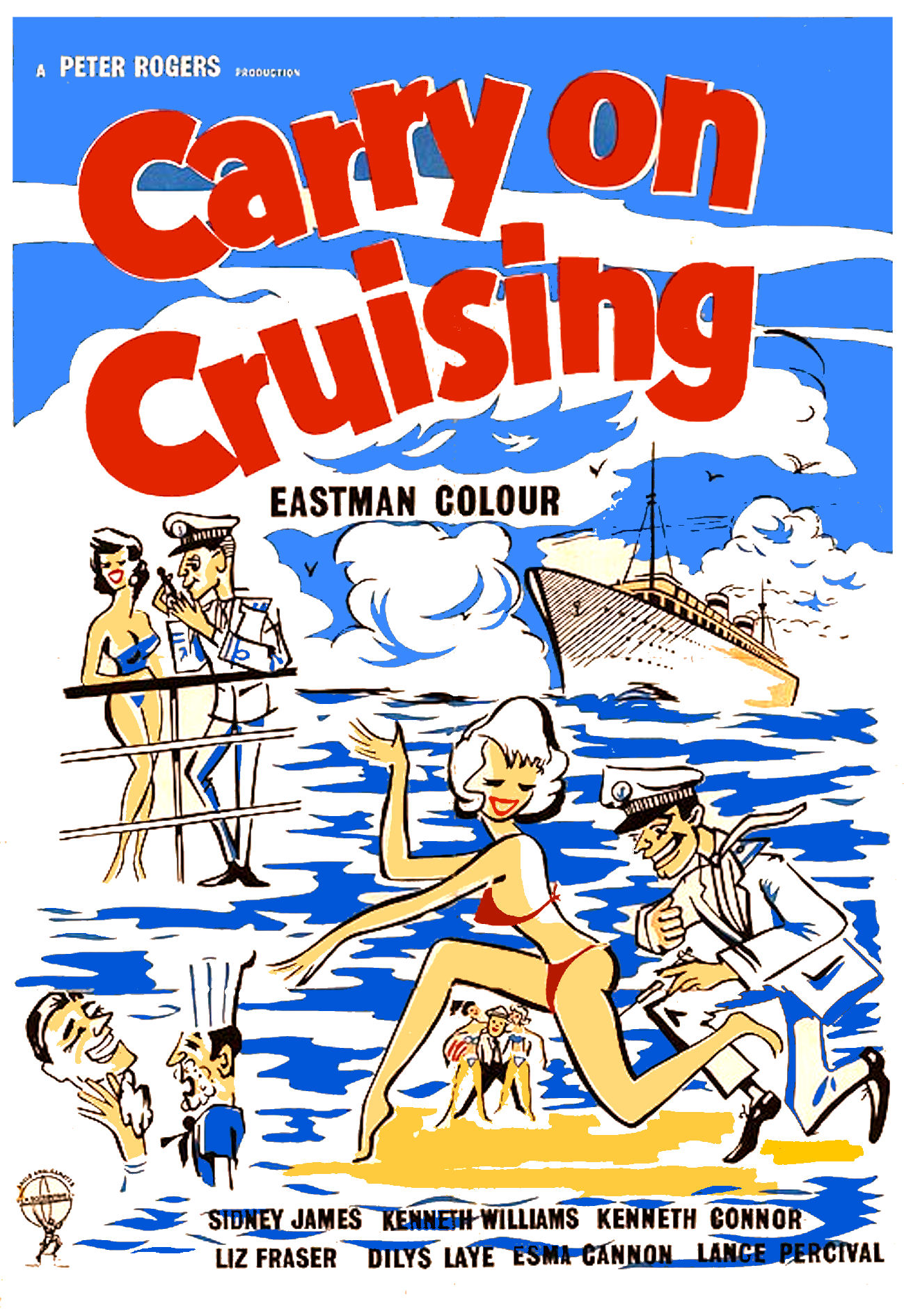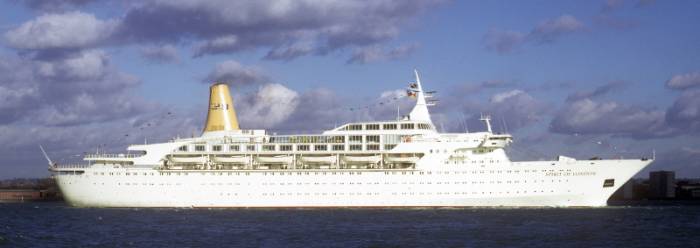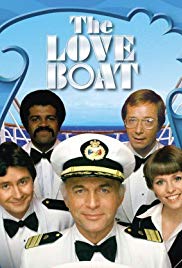After her ground-breaking round
the world voyage, the Ceylon cruised to Madeira and the
Azores and
the Mediterranean, before making
her
first call in Norway at Bergen in 1885.
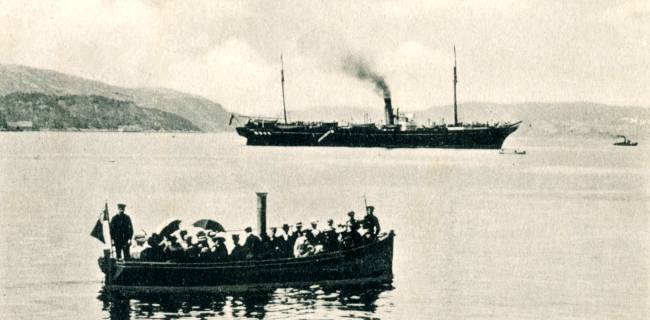
Postcard of the steam yacht
Ceylon, pictured in a Norwegian fjord with a small steam boat full of male and
female passengers, some holding parasols.
Ceylon
is rightly regarded as the first cruise ship in history, and consequently,
The Inter-Oceanic
Yachting
Company Limited
can consider themselves to be the inventors of cruising . Until then, ship owners
had used liners for off season cruising when passenger loads in liner service
were low.
Full time cruise ships did not exist before the
advent of the steam yacht
Ceylon.
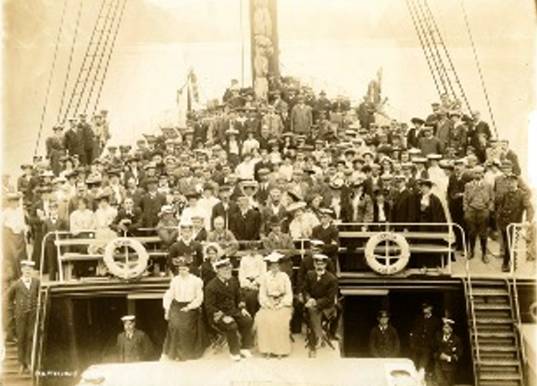
In 1885 she was sold
to Michael Drury-Lavin
of
London, and in
1896,
to Quintin Hogg of London, and
operated by
the PTA - the Polytechnic Touring Association,
a distinctive,
significant and
successful player in the growing
British travel and
tourism industry. While
other
travel agencies had ‘rational
recreational’ and educational origins, the PTA was
distinctive in terms of the
numbers of tourists for whom it catered and the balance of
its portfolio. Considered
progressive in its day, PTA's travel accounts up to 1911
formed an ideology of ‘collective
Continentalism’, which represented aspects
of modernity. Their emphasis
on simple
fun and enjoyment suggested
a degree of
willingness to edge
close to
the boundaries of respectability while on
holiday.
After
its change of status in 1911, the
PTA became an effective adaptor to changing
economic and social conditions –
if not the pioneer it claimed to be.
By its latter days in the
1950s, now known as Poly Travel, it was a
sizeable and well-respected firm,
though not as modern – in the sense of being new
and innovative – as
perhaps it had been in its early years.
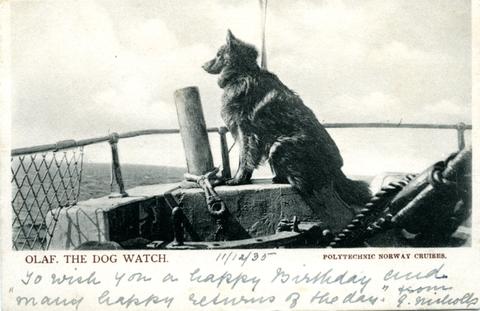
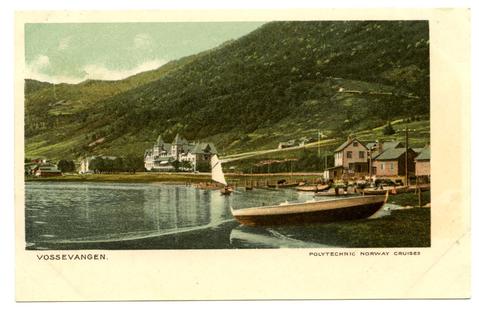
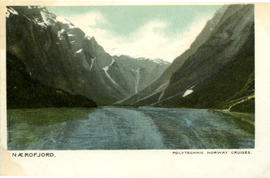
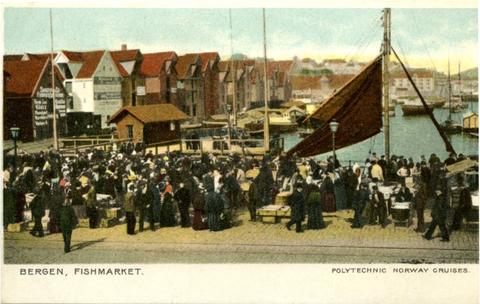
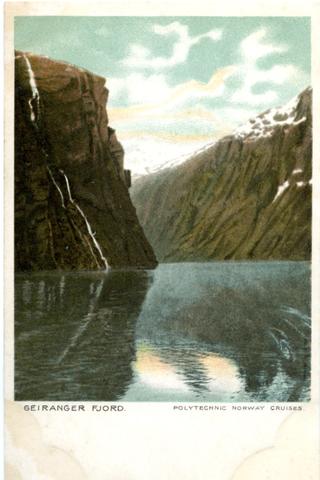
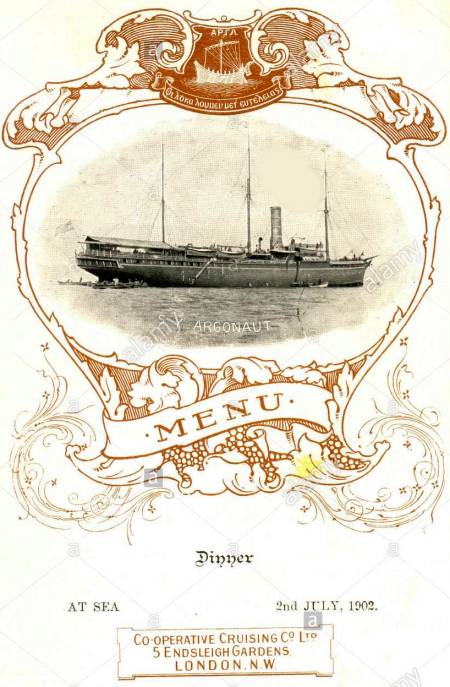
"Concerts and entertainments will be held every
evening on board, and everything will be done to make
the trip the most delightful ever organized.
No
intoxicating liquors and gambling will be permitted on
board, and the regulations of the Poly on land will be
applied to the Poly 'on sea'. "
"..................it's most wonderful what a
wealth of sight-seeing the Polytechnic guides cram into
five days"
The fjord cruises arranged by the Polytechnic
Association were early examples of relatively
inexpensive cruises with a clear focus on education.
One of the travel market's most important players,
Thomas Cook and Son, complained to the English Ministry
of Education the year after the purchase of Ceylon -
because of the government support they received in
connection with the journeys.
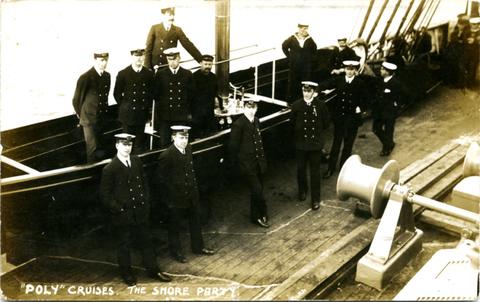
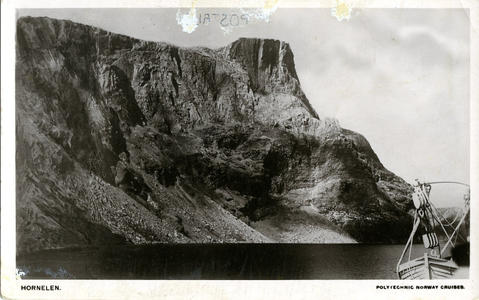
1889
With
utilisation limited to specific seasons, operating
coal-burning steam powered passengers ship was an expensive business, and by the
end of the 19th Century shipowners were resorting to
cruising as a means of generating much-needed out of
season income.
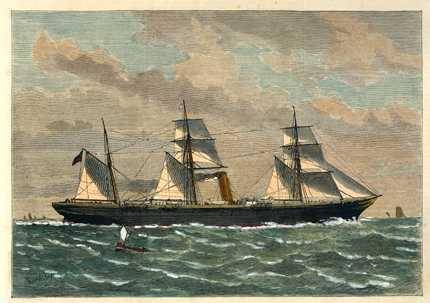
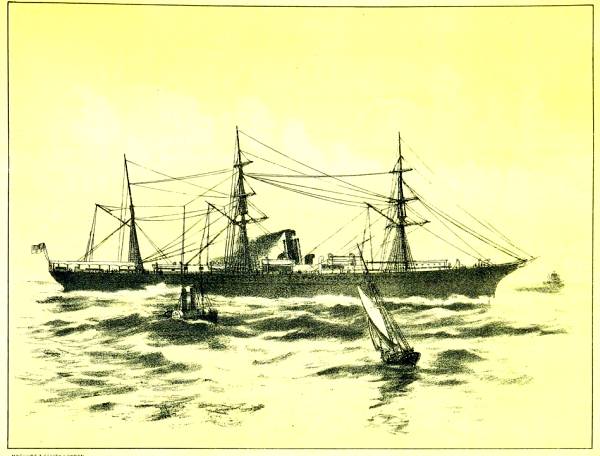
In 1889, the Orient
Line’s sister ships Chimbarazo and
Garonne
were taken off their London – Australia schedule and switched to cruising to
European ports and the West Indies.
1890
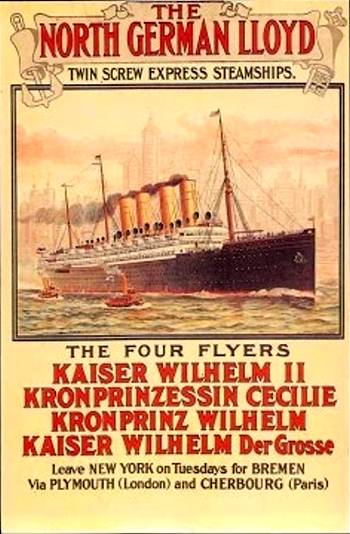
North German Lloyd ‘s
Kaiser Wilhelm II made a three week cruise from Bremerhaven to
Norway in 1890, carrying 215 passengers. The cruise was reported as being a huge success.
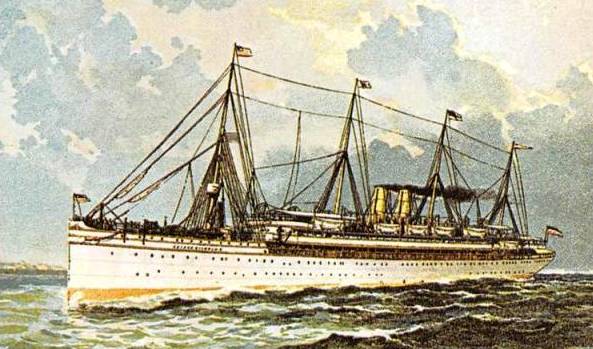
When launched
on 12th August 1902, at the Vulcan Company in Bredow
near Stettin, the Kaiser Wilhelm II represented a great
advance over all former steamers. Her principal
dimensionsThe At approximately 20,000 gross registered
tons, Germany proclaimed she surpassed all the previous
built fast steamships........
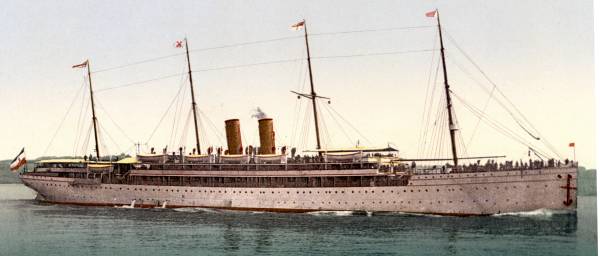
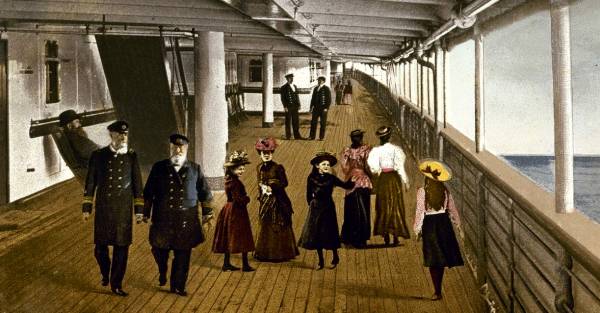
She was certainly sumptuous - her
interiors magnificent.
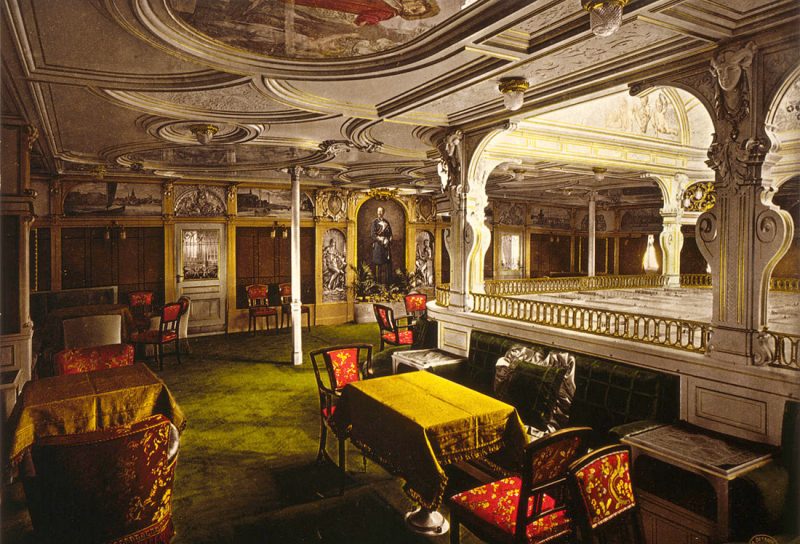
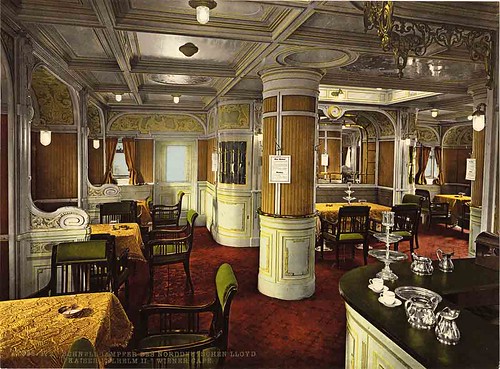
1898
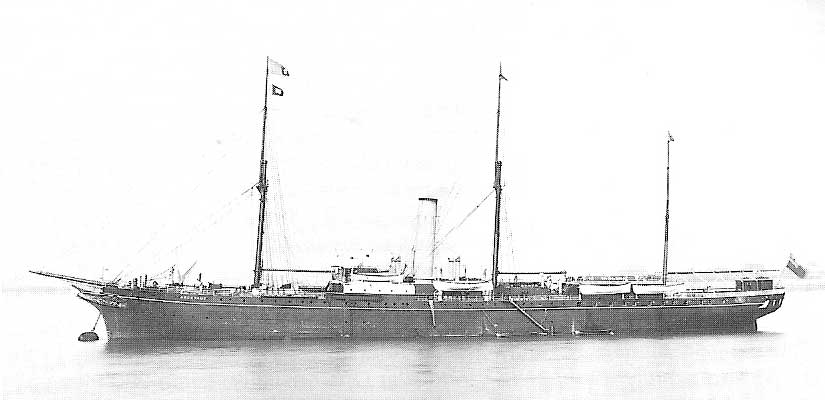
In 1898, the screw
steamer Norfolk, built by Greens of Blackwall,
London in 1878, was sold to her fifth owner, the Co-operative
Cruising Company Limited and fitted out as a luxury steam yacht named Argonaut.
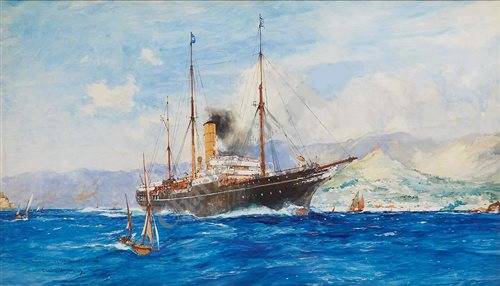
Argonaut leaving
Marseilles, from a painting by Charles Dixon.
Argonaut
was of 3,274
tons register, measuring
334ft x 40ft, and driven by 4 12hp triple-expansion engines.
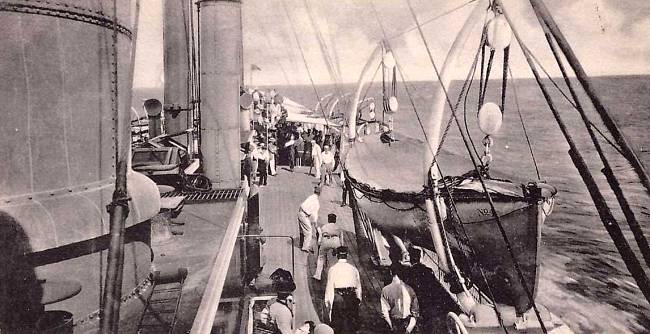
Deck Games on board
the Argonaut. The promenade deck was large enough to play quoits or cricket;
lost balls incurred a fine!
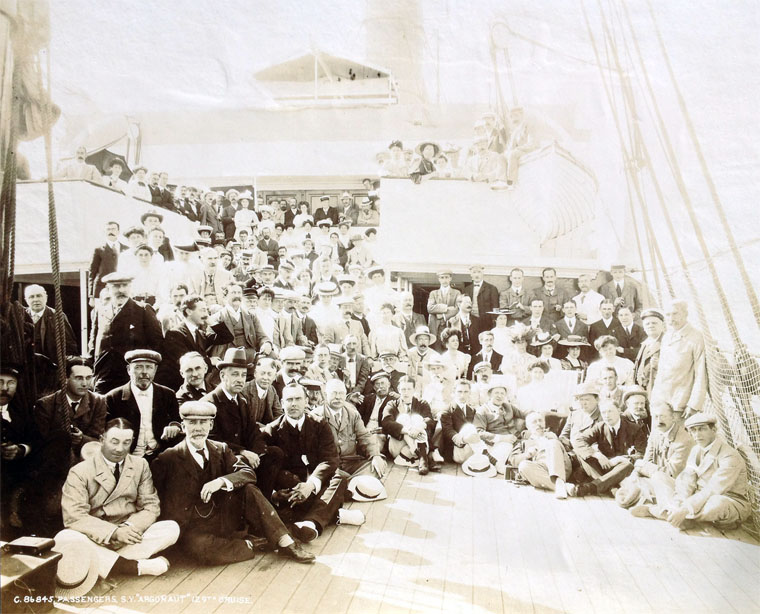
There were several official group
photographs taken by the company which could be purchased by passengers.
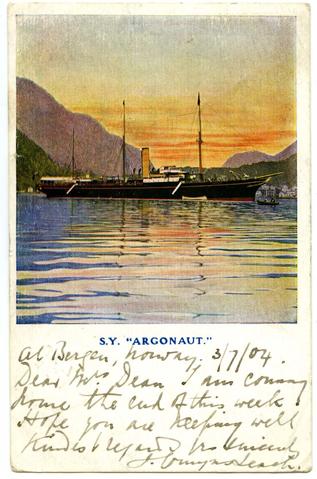
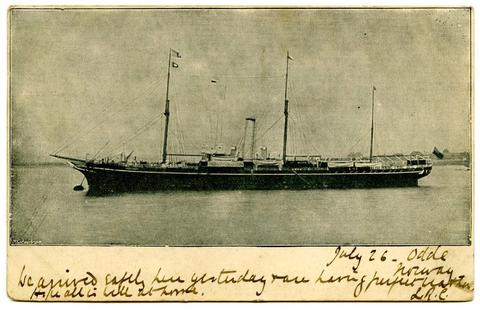
The Steam Yacht
Argonaut was operated by Henry Lunn’s company, World Travel, later to become Lunn
Poly, and was, by all
account, a
magnificent vessel.
A newspaper at the time carried a promotional article about
a forthcoming cruise.
This cruise was an
early package tour which was intended to inform and educate passengers. There
was enough accommodation for up to 120 passengers and 120 crew. Argonaut had
electric lighting and a large refrigerated food store. It had been fitted
out with new boilers and quadruple-expansion engines. The facilities on board
were first class, the food was wonderful, concerts and lectures were organised
and there were opportunities to exercise.
STEAM YACHT SINKS;
IS HIT BY STEAMER
Dover 29th
September1908
The
tourist steam yacht Argonaut which left London yesterday
bound for Lisbon with 250 person aboard, including
passengers and crew, went down between Dover and Dungenness this morning after having been in
collision with the steamer Kingswell in a fog. All on board the Argonaut took to
the boats and came ashore here in safety. The Argonaut sank so quickly that
those on board barely had time to save themselves. Fortunately the sea was
smooth and the transfer of the passengers and crew to the small boats was made
speedily. There was no panic. The peoplePlymouth 29th September1908 ~ The
tourist steam yacht Argonaut which left London yesterday
bound for Lisbon with 250 person aboard, including
passengers and crew, went down between on board the Argonaut lost everything
they possessed. For an hour the Argonaut's boats groped about in the fog for the
steamer Kingswell, which they finally reached and boarded. Finding that vessel
in a sinking condition the passengers again took to the boats and were
ultimately picked up by the steamer Southwood, which brought them in here.
The Crew,
Stewards, and Captain were the last to leave the
Argonaut, as water began washing under the bridge on the
upper deck. The crew of the Argonaut were thrown into
unemployment after the sinking and a fund was opened for
their assistance, with contributions from passengers who
had previously been on voyages on the yacht.
Each crew
member also received a (generous!) gift of £1 from the
Co-operative Cruising Company.
1900
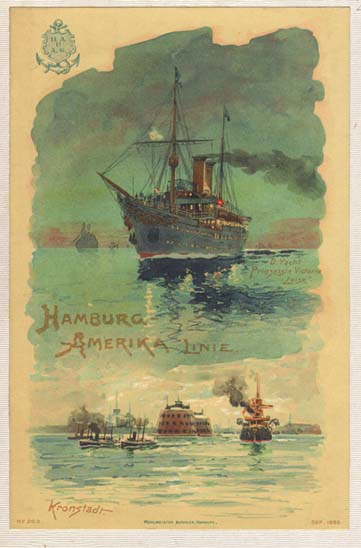
The
first vessel built exclusively for luxury cruising, was
the Prinzessin Victoria Luise of Germany.
With
cruises targeted toward wealthy travellers, she
was designed to look more like
a privately-owned yacht
than any of her commercial counterparts. She had a
trim hull, painted all in white with two masts, one
fore and aft, and two tall, slim funnels amidships.
She had a rounded stern and a richly decorated
clipper bow, complete with a bowsprit and a
figurehead of the German princess after who she was
named..
She was a
magnificent purpose-built luxury yacht, unlike most of her contemporaries, which doubled as
liners outside the season. She was specifically built for cruising, Carrying up to 180 passengers, she was popular with
German and English speaking clientele on both sides of the Atlantic.
She had a
double bottom extending the entire length of the vessel,
divided into 26 water-tight sections, with the hull
itself being further divided into 19 water-tight
compartments, by 16 transverse bulkheads, reaching to
the upper deck, and one longitudinal bulkhead in the
engine room.
The bulkheads
were distributed in such a manner that even if two
adjoining compartments were filled, the vessel would
still float. Below the upper deck there were 4 steel
decks extending the entire length of the ship.
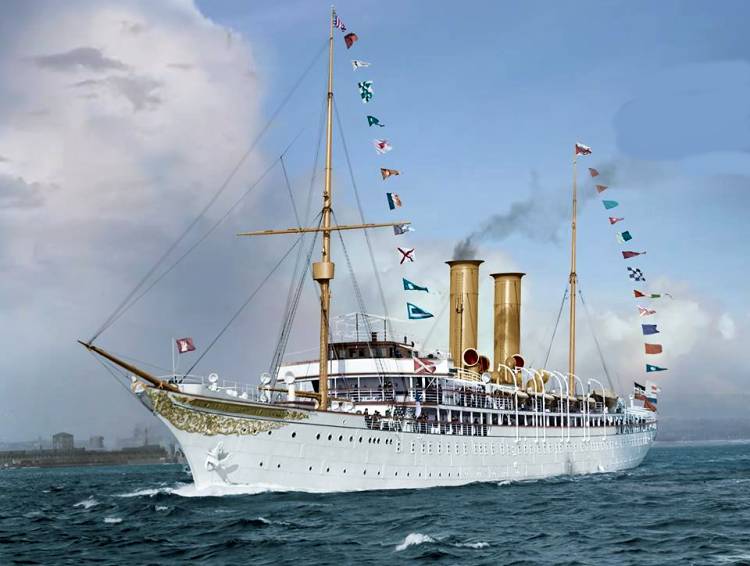
Designed
by Albert Ballin, general manager of the Hamburg-America
Line, built by Blohm and Voss of Hamburg, she was completed in 1900.
In conformity
with requirements of the Imperial German Admiralty,
structural arrangements had been made to permit the
mounting of a considerable number of guns, so that in
time of war, the ship could be used as an auxiliary
cruiser.
Her engines
and boilers were built at the A G Vulcan Company's
works, and consisted of 4 sets of four-cylinder,
three-crank, quadruple expansion, inverted, vertical
engines with surface condensers balanced on the Schlick
system, representing a total combined indicated
horsepower of from 38,000 to 40,000. They were so
disposed that two sets were placed fore and aft on each
shaft, so as to make it possible to fix a transverse
watertight bulkhead between them, as well as a
longitudinal one, thus increasing the number of the
watertight compartments and consequently the safety of
the ship.
Each two sets of her enormous engines, connected to a
propeller shaft 42 meters long, which drove a
four-bladed bronze propeller of 7 meters' diameter. The
steam was produced by 12 double and 7 single-ended
boilers, working at a pressure of 15 atmospheres, and
arranged in 4 groups, each of which had a funnel of 5
meters in diameter, and 40 meters in height.
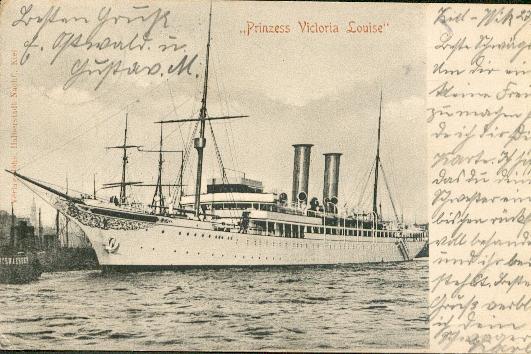
Prinzessin Victoria Luise's design
was based closely on Kaiser Wilhelm's steam yacht Hohenzollern of 1894,
incorporating features from the design of the most prestigious
contemporary first class transatlantic liners - without the impediment of
having to cater for second class and steerage passengers - or cargo!
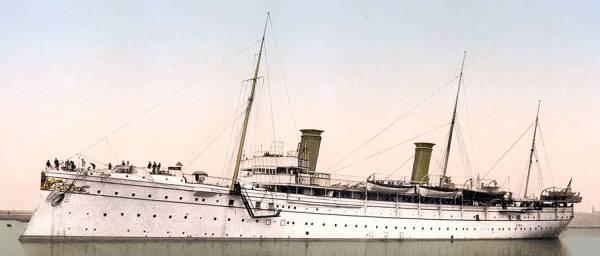
Kaiser Wilhelm's steam yacht
Hohenzollern of 1894
Prinzessin Victoria Luise's dining
room and lounge were covered by an ornate glass dome and there was a well-appointed
library and a writing room. There was even a state apartment for the Kaiser - although there is no
record of him ever having used it. A letter on headed notepaper from the Prinzessin Victoria Luise showed that Franklin
D. Roosevelt and his mother Eleanor cruised in her in 1904,
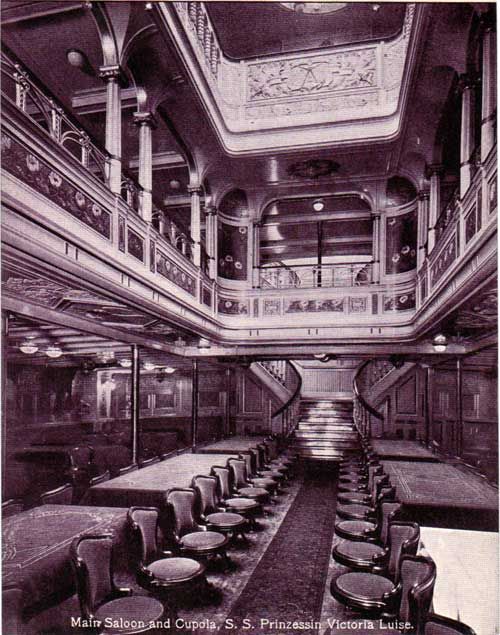
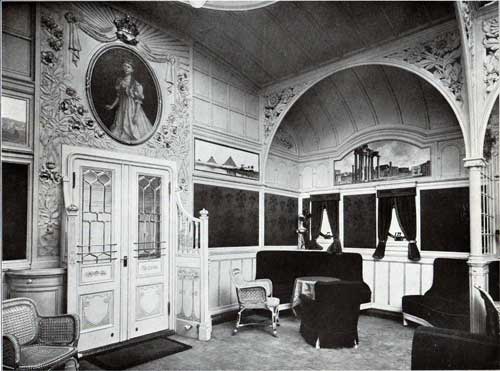
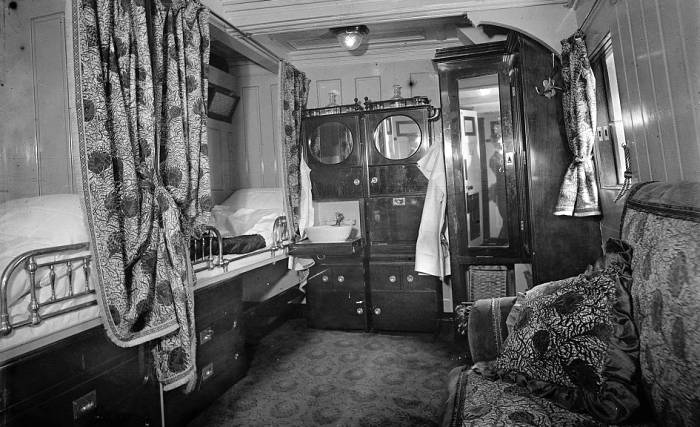
She was used for cruises in the Baltic and
Atlantic until becoming stranded on an uncharted reef at Plum Point near Kingston, Jamaica, on 16th December 1906, after
which she became a total loss. The only victim of the tragedy was her
Captain, who, sadly, shot himself.
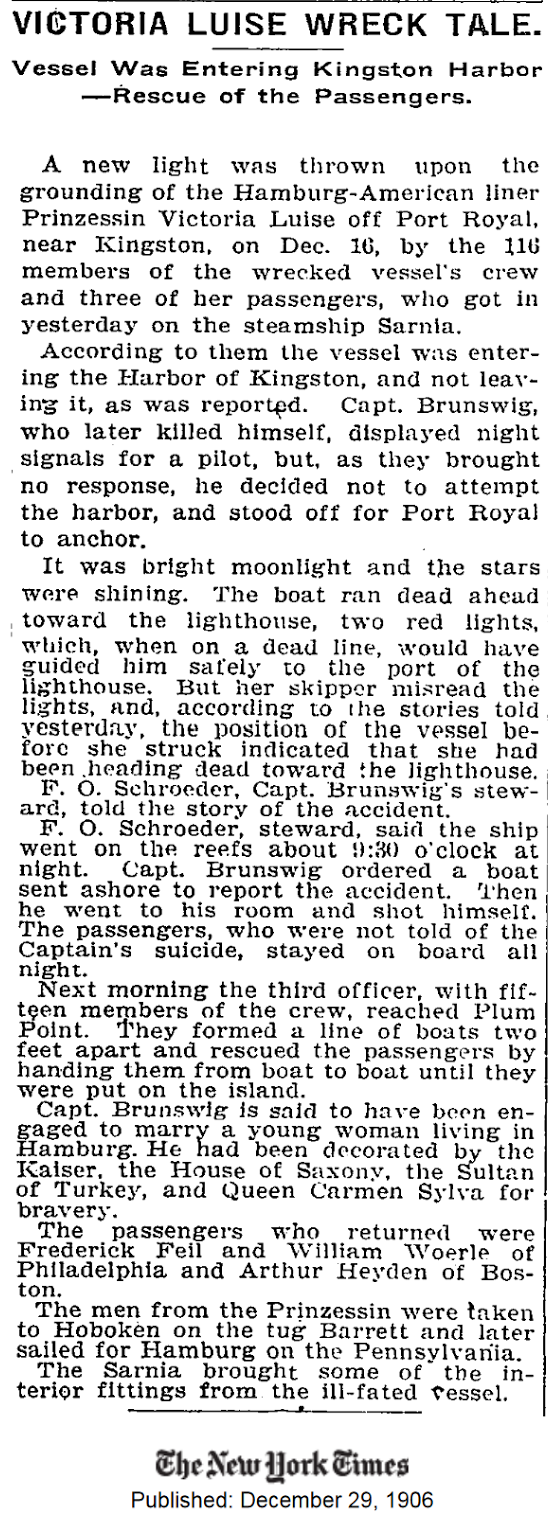
1903
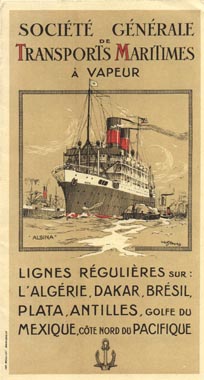
In 1903,
France's Société Générale des Transports Maritimes à
Vapeur bought the SS Île-de-France, fitted her
out and allocated her to leisure cruises, which was
extremely original at that time.
No less than
eight tourist vessels visited Spitzbergen during the
Summer of 1906, the majority of them British, French,
Dutch and German. Among them was the French Tourist
Steamer, the Ile de France, of 3,488 tons.
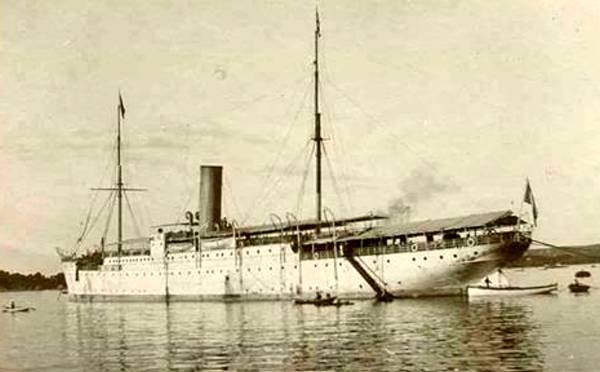
In a venture
organised by the Société Générale des Transports
Maritimes à Vapeur (SGTM) in conjunction with the
Revue Generale des Sciences, the Ile de France cruise,
led by the eminent Swedish geologist Nils Otto
Nordenskiold, cost 1,850 Francs - plus a supplement of
400 Francs for those wishing to join the various hunting
trips.
For her
tonnage and dimensions, the ship's facilities exceeded
that of many luxury yachts. There was accommodation for
214 tourists in roomy cabins, of which 42 had a single
bed, 71 with two beds and 10 with three beds (there were
no bunk beds). Each cabin was furnished with a large
washbasin for each person, a chest of drawers, a
cupboard, coat pegs, a sizeable mirror, shelves, a desk,
a cane bench, a chair for each person, two lamps, an
electric ventilator and an adjustable heater. The ship
was lit by electric lights throughout and equipped with
central heating, which in winter was sufficient to keep
all the cabins, rooms and corridors warm. The ship had
seven bathrooms, each provided with a shower. There were
two saloons on the upper deck; the largest of which
seated 184 diners, while the smaller one served as a
lounge, used especially by women. Men were therefore
invited to use it with discretion and only when there
was room. A spacious smoking room also located on the
upper deck, providing a meeting place for men. There was
a large open space at the rear of the upper deck where
tourists could set out their deckchairs and where there
was a shelter in case of bad weather. The Ile de France
also carried a steam launch of 35 horsepower, which
could simultaneously tow all the launches.
The cruise
departed Dunkirk in July, with 184 passengers, including
the artist Felix Fournery and Emile Gallois, the writer
Rene Bazin, the photographer Paul Grenor and the
cameraman Emile Lauste. The ship reached Lofotoen on
Bastille Day, and at Tromso horses and Norwegian hunters
were embarked, together with Johan Kjeldsen, an
experienced ice pilot, whose role was to ensure the safe
navigation of the ship through the ever shifting ice
floes.
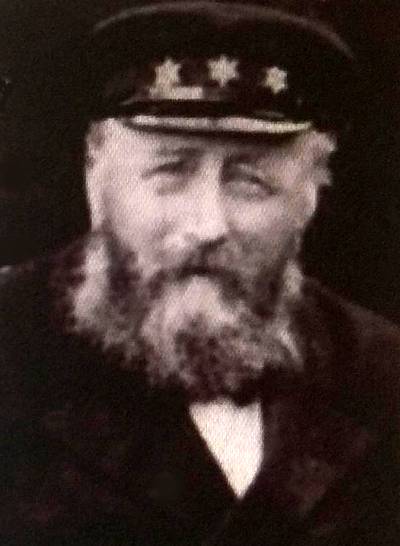
Captain Johan
Kjeldsen, Ice Pilot
Forty-eight
hours after leaving Tromso, the ship entered
Recherchefjorden, and anchored alongside several
Norwegian whaling vessels and the German tourist liner
Oceana.......
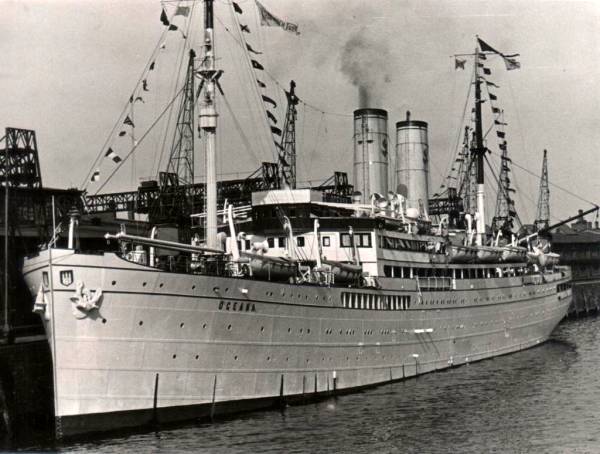
"Chasseresses
ou non" huntsmen or not, the Ile de France's lavish
brochure had pictured polar bears and a variety of
hunts, with the prey consisting of whales, reindeer, au
lagopede des Neiges, aux petits echassiers et au grands
palimpedes de l'ocean boreal - eider, bernache goose,
arctic petrels, pigeons, cormorants, the scarce blue
fox, and great seals of the ice-pack.
Activities
unsuited to the more genteel passengers of the Cruising
Yacht Vectis I would suggest.....À
chacun ses goûts...
After leaving
Virgohamna, the ship's French Captain, lured on by the
remarkably favourable weather and ice conditions, took
the Ile de France into Raudfjorden, a remote and rarely
visited fjiord on the north coast. Suddenly, and without
warning, at 0800 in the morning the ship shuddered to a
grinding halt, having hit a submerged rock near the
fjiord's entrance. As the tide turned, she began to list
dangerously and orders were given to jettison ballast,
together with 50 tons of coal reserves. Unfortunately,
this manoeuvre had little effect and the ship was left
stranded in a precarious and exposed position.
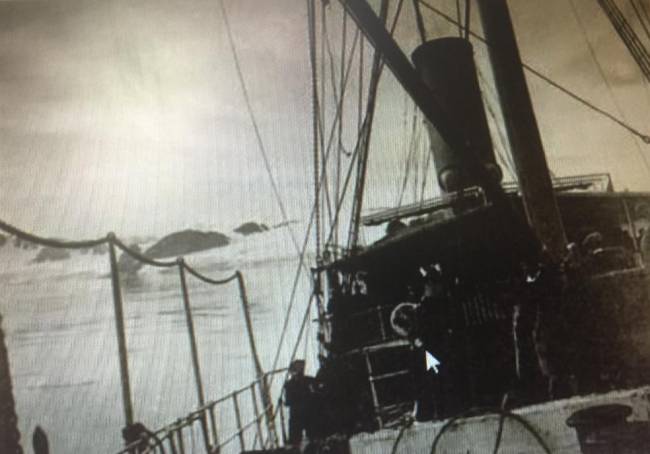
Fortunately,
the German photographer and explorer Theodore Lerner was
in the vicinity, in his chartered 12 ton steamer
Express, which proved under-powered to tow off the Ile
de France. He quickly set off in search of a larger, more
powerful ship, and located the Dutch cruiser Friesland
in nearby Liefdefjorden, but by the time he returned
most of the French tourists, fearing that their ship
would sink, had been ferried ashore with a limited
supply of food and water. At high tide the following day,
and much to the relief of her Captain and crew, the Il
de France was refloated. Soon her relieved passengers
were back on board, proclaiming "Vivre Lerner! Vivre la
Holland"
1904
Encouraged by the success of their
former ship, the Ceylon, P&O converted the
Rome to a cruise ship,
renaming her The
Steam Yacht Vectis.
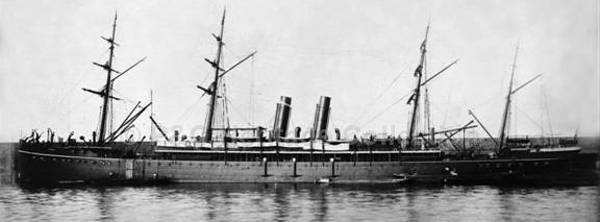
Built by
Caird and Company of Greenock, and launched on 14th May
1881, Rome
and
her sister ship Carthage were the first P&O ships to
accommodate second class passengers aft and the first
class amidships. At 5,545 tons, she had been engaged on
P&O's regular mail runs to India and Australia.
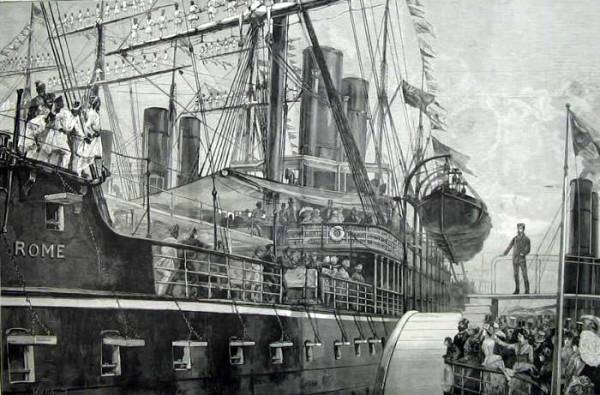
Rome
departing Tilbury in 1886, from The Illustrated London
News.
When you're wounded and left on Afghanistan's
plains, and the women come out to cut up what
remains, jest roll to your rifle and blow out your
brains and go to your gawd like a soldier. Rudyard
Kipling
Read more at: https://www.brainyquote.com/quotes/rudyard_kipling_152251
When you're wounded and left on Afghanistan's
plains, and the women come out to cut up what
remains, jest roll to your rifle and blow out your
brains and go to your gawd like a soldier. Rudyard
Kipling
Read more at: https://www.brainyquote.com/quotes/rudyard_kipling_152251
When you're wounded and left on Afghanistan's
plains, and the women come out to cut up what
remains, jest roll to your rifle and blow out your
brains and go to your gawd like a soldier. Rudyard
Kipling
Read more at: https://www.brainyquote.com/quotes/rudyard_kipling_152251
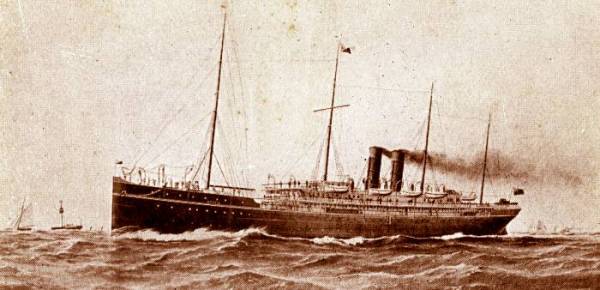
'Vectis of 6,000 tons and 6,000 horsepower has been
specially fitted as a yacht to carry 150 passengers,
and will be regularly employed on the Pleasure
Cruises which have become popular in combining the
most delightful Holiday Excursions, with the benefit
of sea air, under the most luxurious conditions. No
expense has been spared in adapting the Vectis for
this purpose, and her cabin accommodation, Saloons,
Card, Recreation, Smoking and Photographic Rooms
will be found equal in all respects to what they
should be for the work in which the ship will be
engaged.....'
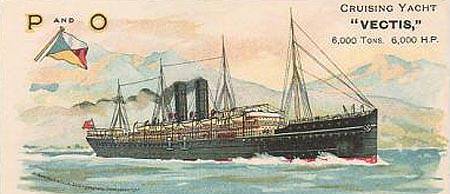
At first, it
was very much for the upper classes, People were
interested in sailing for pleasure, but you had to have
money and time to spare.
P&O’s first
cruise ship, Vectis, entered service in 1904, and after
cruising was recommended in the British Medical Journal
for its health benefits, thousands of people signed up
to see the world.
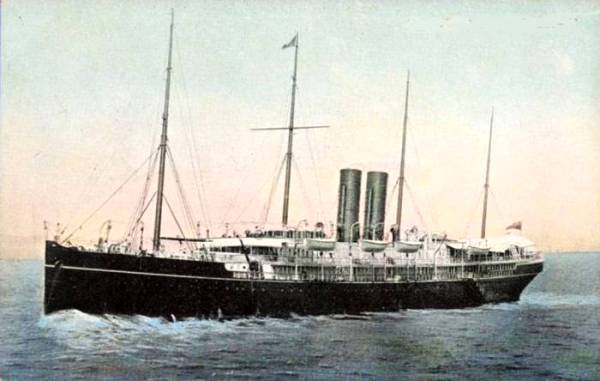
Renamed and extensively refitted,
the stylish Cruising Yacht Vectis carried 150 passengers
in first class accommodation, on cruises to
Norway. Sailing from
Tilbury on 6th July, she visited Bergen, the North Cape
and Spitzbergen. Tickets cost between forty and seventy
guineas, with Thomas Cook & Son providing shore
excursions at extra cost.
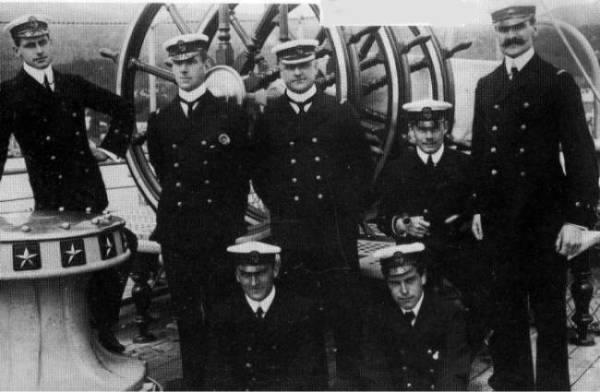
Vectis's hand-picked deck and purser's officers wore
Royal Navy style frock coats, with eight gold buttons,
distinctive P&O cap badges and the Company's rank
insignia. The ship's Commander, Captain Thompson is at
the centre of the photograph, while the moustachioed
officer on the right is the ship's Purser.
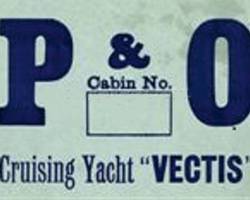
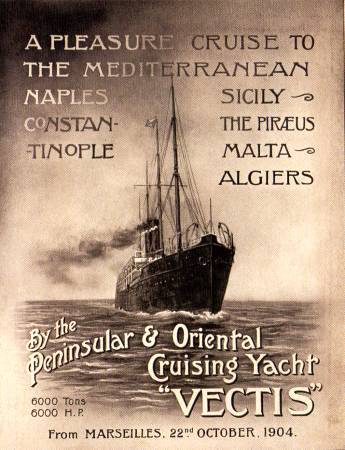
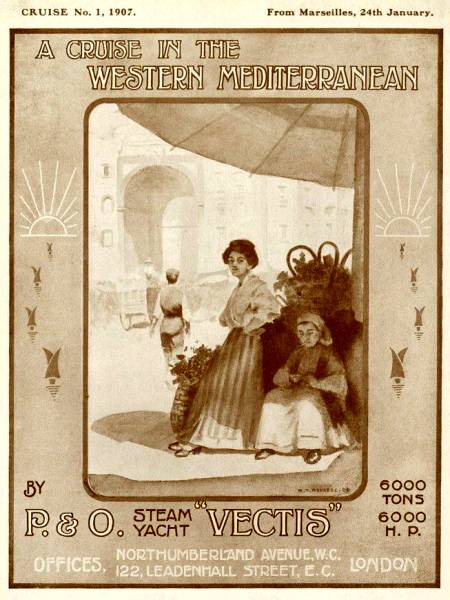

Encouraged by
her success, she was joined by the ss Malwa for cruises
throughout the Mediterranean during the summer months.
By 1909,
Vectis and Malwa were well established.....
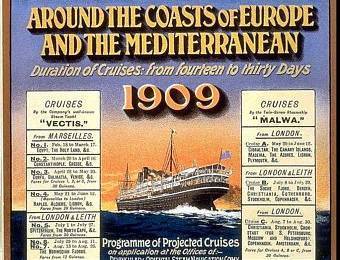
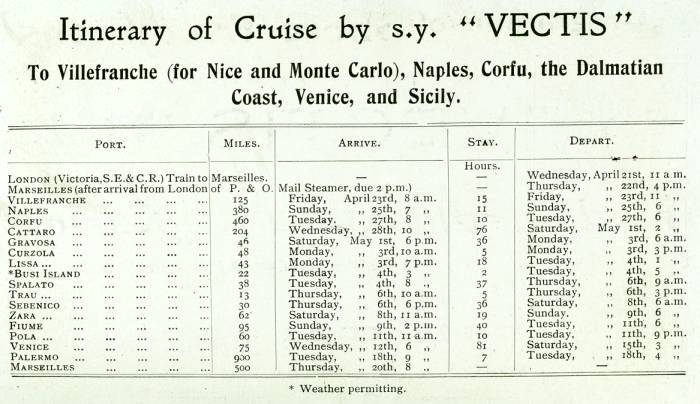
A
comprehensive 1909 Itinerary, National Maritime Museum
Archive
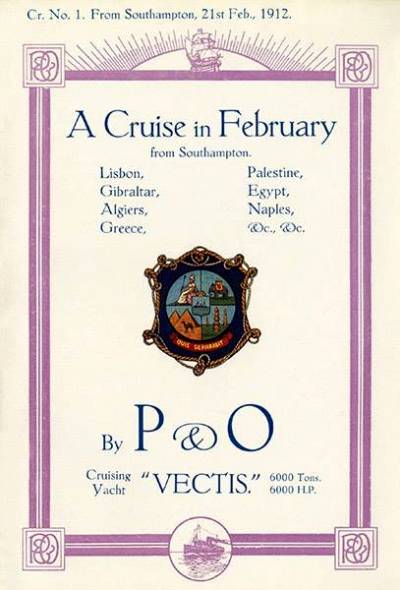
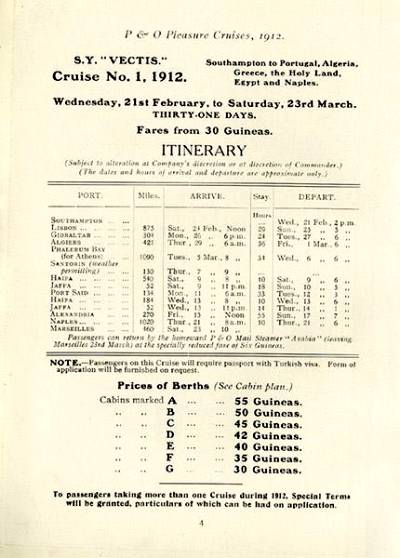
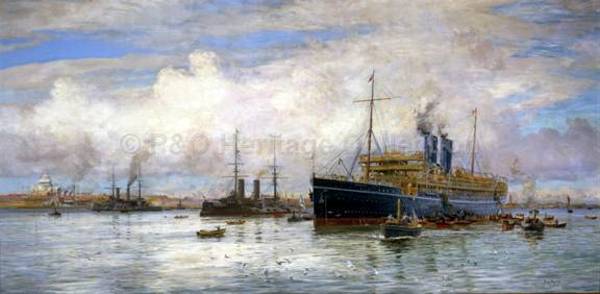
Malwa at the Russian port of Kronstadt, Saint
Petersburg's main seaport. in 1909, when Russian naval
officers were entertained on board. Painting by William
Lionel Wyllie, P&O Heritage.
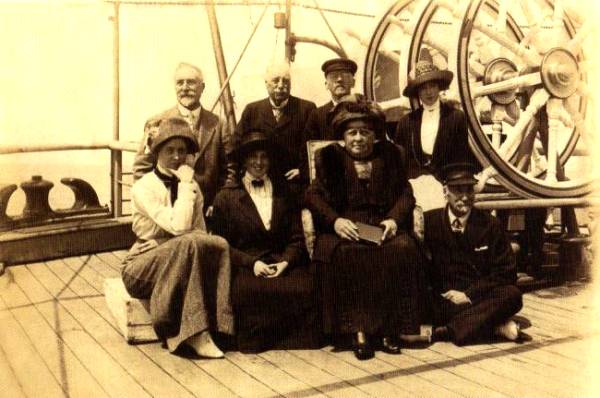
Meanwhile,
passengers struck a rather stolid pose for a group
portrait on board the Cruising Yacht Vectis.
'....there
are beautiful drawing and lounge rooms, the finest
smoking room we have ever seen, the dining room is
splendidly situated and the meals are excellent and well
served, the steward in charge, Mr Dust, the most
courteous of officials we have had the pleasure of
meeting, the cabins are light and well ventilated and
the beds most comfortable; our cabins being No 78 and
79, our neighbour, the barber Mr Sales, who is most
obliging and intelligent; it was a pleasure to be shaved
by him, and his shop is the largest we have ever seen on
any ship. There are three dark rooms for photographers
which I have found most useful. The promenade deck is
very spacious, eight trips round it the mile. This
splendid ship carries a crew of 196 and has
accommodation for 183 passengers and a coaling capacity
of 1,800 tons. Wrtten by Edward Rawdin, a seasoned
passenger who completed three cruises aboard the Vectis..
Among
Vectis's passengers on her inaugural cruise were the
acclaimed marine artist William Lionel Wyllie and his
wife Marion.
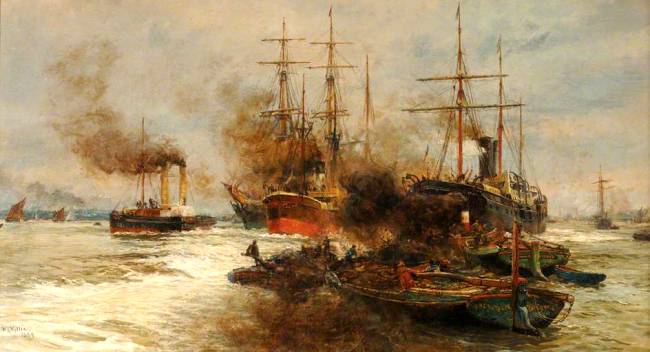
Together with
148 fellow passengers, they boarded Vectis in the London
River.
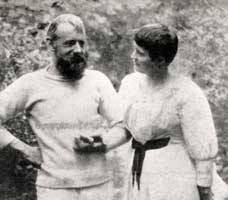
A prolific
painter, William was working right up until his death in
1931, aged 79.
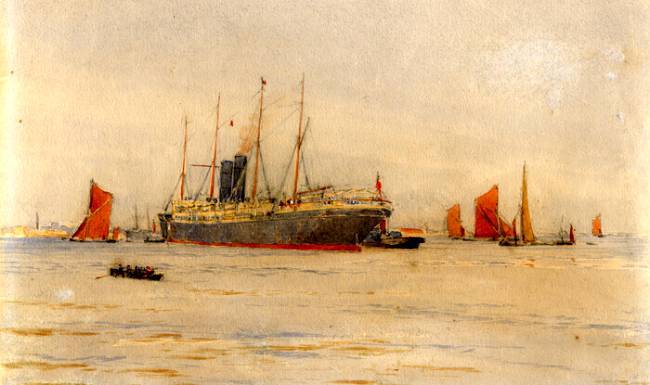

On board
Vectis, Marion, researched and began writing Norway &
Its Fjords, which was published by
Methuen & Co
of London in 1907.
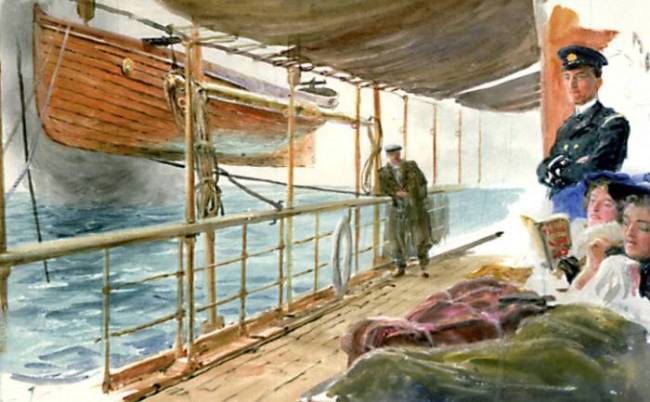
........they
lay drowsily extended in various positions of comfort on
their chairs on the broad white after-deck, the happy
moment after lunch; too soon to get to work or play, the
tremor of the great screw acting as the mother's foot on
the cradle rocker.
From:
Norway and its Fjords by Marion A. Wyllie. With sixteen
illustrations in colour, by William Lionel Wyllie, RA.
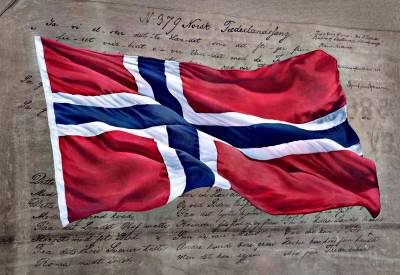
'Our ship
steams steadily on, and it would seem as though there is
no end to the labyrinth of ice-worn rocky islets...'
Marion Wyllie, Norway and its Fjords.
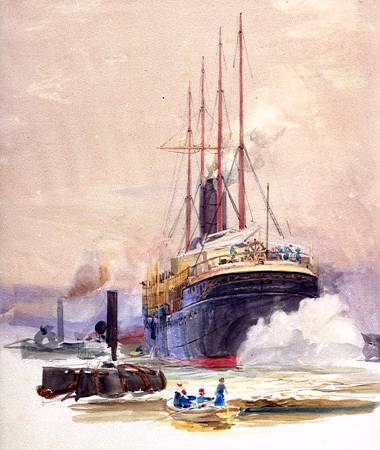
Vectis at
Kristiania -
William Lionel Wyllie
Originally called
Christiania, from 1877 the name was spelled Kristiania,
and in 1925 was changed back to the city's original
name, Oslo.
'The ship is
still plunging through the waves, and now the
passengers, who still brave the elements, have dwindled
to a very small party. The island of Karmo comes in
sight on the starboard bow, and all sorts of jagged
rocks go by as we plunge northward. A long journey
outside the Skjaergaard is not a pleasant prospect in
weather like this, but all at once we notice that our
wake is not right astern , but trends away to the
starboard quarter.....'
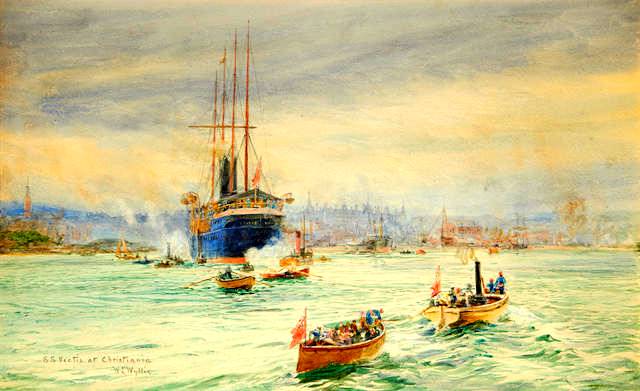
Vectis at
Kristiania
'It is clear
that kind-hearted Captain Thompson has made up his mind
to take us up inside the islands.
The sight of
many pale faces, and all those empty chairs, has moved
him to take the longer, and to him, no doubt, more
troublesome route. Soon, we are under the lee of
Skudesnas, and one by one limp, red-eyed bodies, with
hair out of curl and rumpled clothes, make their
appearance, blessing the Skjaergaard and good Captain
Thompson.'
Much of the coast of Norway is
penetrated by fjords and fringed by countless islands,
islets, rocks and reefs, known as the Skjaergaard
- a Norwegian word,
literally meaning a rock rampart.
At Recherche Bay, Spitsbergen they heard
loud bangs as if a gun was fired, when large
pieces of beautiful green ice drifted by,
colliding against each other. One piece came
very close and actually grazed the side of
the ship making a sound like a tin can
struck by a hammer, as one excited passenger
noted in her diary.
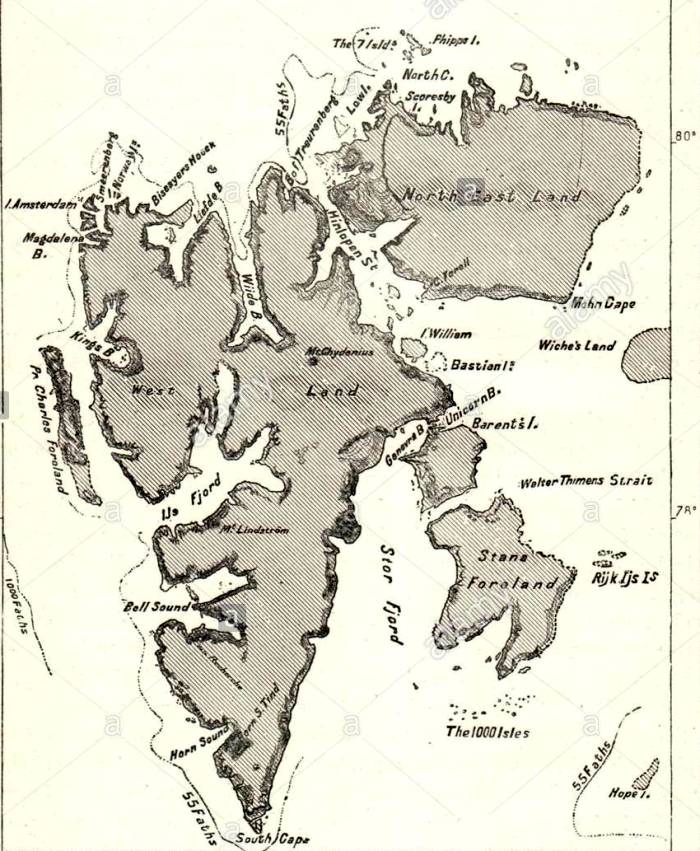
The Spitsbergen Archipelago, Ssvalbard
Norway- Sketch-map c1885
The first cast of the lead was forty-five
fathoms, the second forty-two. Thump! Thump!
Thump! went the propeller as the engines
reversed , and a great seething mass of foam
burst out from under the counter, and washed
slowly forward as the ship lost her way.
Thump!Thump! Thump! and the after end of the
Vectis is the centre of a perfect vortex of
fierce little waves, which breaking off in
ever widening circles, dimple the surface of
the dark green fjord.
"She's going astern, Sir," sings the
leadsman.
"Let go," says a voice from the bridge.
There is a tremendous splash , and the chain
rushes madly out through the hawsepipe with
a harsh grating roar, whilst a thick mist of
iron rust and powdered paint rises into the
air, through which the Lascars on the
forecastle are dimly seen, like phantoms
tending the whirring cable as it leaps up
from the depths of the chain locker. Shackle
after shackle goes plunging down overboard,
and the brown cloud covers the whole fore-part of
the ship, coating everything in dust.....'
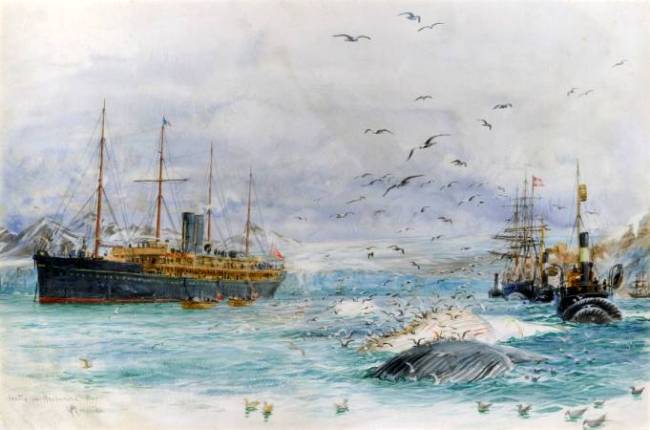
Vectis anchored in Recherche
Bay on the west coast of Spitsbergen.
'Wherever
the Vectis steamed, the Ile de France had just left. Her
name in giant letters of white was painted on the cliffs
of the Naero Fjord. In Recherche Bay we enquired of the
sailors on board the whalers, Had the Ile de France been
there? Had the passengers shot any bears? 'Yes' was the
answer to the first question; 'No' to the second. Had
they caught any foxes? 'No'.
It was not
the season for the one or the other.'
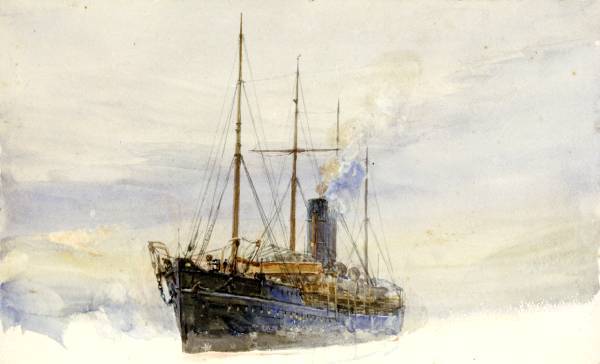
In October
1912, Vectis was sold
for £11,040 to the French Government, who proposed to
convert her to a hospital ship, but in 1913, she was
sold to Italian shipbreakers.
